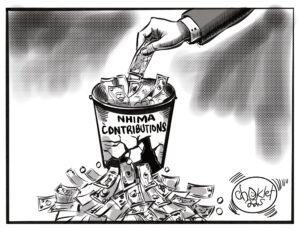ZESCO corporate affairs manager Dr John Kunda has assured the nation that the four-hour load shedding the country will be experiencing will not exceed the stipulated 15 days.
Speaking when he featured on Hot FM’s Red Hot Breakfast, Monday, Dr Kunda explained that the load shedding was caused by maintenance works at one of the cylinders at Kafue Gorge Upper.
“We assured the nation that load shedding is the thing of the past. We have good inflows, the inflows that are coming from both the Itezhi-Tezhi Dam and the allocation from Kariba Dam is excellent, it is unprecedented. So, water levels are not an excuse at all. Let me just give an explanation, at Kafue Gorge Upper there are what we call hydraulic cylinders that control… you know, water from a river goes through a tunnel then that tunnel separates into six different manifolds, which each one goes to propel the turbine. So, those particular manifolds are closed and controlled by a valve and that valve has hydraulic cylinders that help it to close so that you are able to control the amount of water that is going to propel the turbine,” he said.
“The engineers have seen a major weakness on one of those particular cylinders. So the cylinder has not failed, they can continue operating, but our engineers have carried out a diagnosis and they are saying that there may be a problem with this cylinder because the rate at which it is closing is not clinically precise. So, they need to take it out and work on it to prevent too much water getting into the turbine which may damage our turbines. Turbines are very expensive. So that is what will lead to about the loss of 160 megawatts.”
He stressed that the stipulated load shedding would last 15 days.
“We are saying that it is not a given that we may load shed. So, that is why we are talking about stage one, that is one to four hours if it happens at peak hours. Because we can meet the average peak hours in the country without any problem, but about 18:00hrs, that is the time when people use electricity in Zambia a lot, both industry and household. When that demand far exceeds the system and the system shows signs of instability, we will implement load shedding for about two hours, three hours but we will try to keep it within three hours. The level is a span between one hour to four hours, that is the general, but we may keep it to the average, which is about two to three hours. We hope that it can even be done in less than 15 days, but just for safety we are thinking that 15 days is a very good estimate. This is being done by our engineers, they do this almost all the time. So, they are taking it out, dismantling it and putting it back and then try it out. So, we are hoping that worst case scenario 15 days is a very good estimate. It is mathematically certain because these can be projected and defined, it is engineering and mathematics,” Dr Kunda said.
“So, we are on firm ground. Wilson Banda, our engineer there and the team are very comfortable that 15 days is a very good estimate of the work to be carried out. The guarantee is that the people who have diagnosed this problem are the same engineers who work on this everyday and they have done it before. In Africa, Zesco Limited is rated amongst the top three in terms of operation efficiency. We are only compared to the big boys in the industry. Our operation efficiency is about 98 percent. It is all because our engineers can detect a problem before it actualises, rectify it and put it back into operation. They dismantle the entire turbine and put it back. These are our own engineers based here in Zambia. So they are very confident that 15 days is a very good estimate.”
Dr Kunda said some consumers may not be affected by the load shedding.
“For years Zesco has been providing this power, they have been maintaining this equipment for years. We have never had a breakdown on major components, while some of our independent power producers will tell you that today it is broken. Zesco Limited has not come to you that ‘it is broken’, this machine is not broken. The machine is available and it can continue working, but as a precautionary measure, when you see a slight weakness with this equipment you don’t wait. So, these guys checked it out because they are analysing and checking these equipment everyday. On average we are keeping it to three hours at peak hours that is between 17:30 and 21:00hrs. Others may actually not feel it, they may not actually be cut off. But, what we are saying is let the public be aware that there may be implementation of load shedding between 17:30 and 21:00hrs. If the power goes off do not bother the center, we are making that announcement and we are very transparent,” said Dr Kunda.
And Zambia Association of Manufacturers (ZAM) president Ezekiel Sekele called on Zesco to be proactive in communicating with manufacturers on the load shedding schedule.
“Any disruption to energy supply impacts on any sector, impacts on the house, impacts on the economy and manufacturing sector. Having engaged with Zesco beyond what they have released, I am in a position to understand the challenges that they are faced. They are faced with an unprecedented challenge. So what they are looking at is preventive maintenance to manage the cylinders. What I urge Zesco, we need proactive communication. Zesco has confirmed to me that they will continue to raise awareness around this issue. They will create many platforms for the public so that they are aware about this. So from where I stand it is up to to us to save energy and to support Zesco. So, I call upon Zesco to continue to be proactive, to communicate more. If at all the industry has to be affected there should be that proactive communication with the industry, because we wouldn’t want 17:00hrs to 21:00hrs, industries switch off. That is where we continue to engage with Zesco so that we manage this sudden and most likely limited supply of energy,” said Sekele.
























